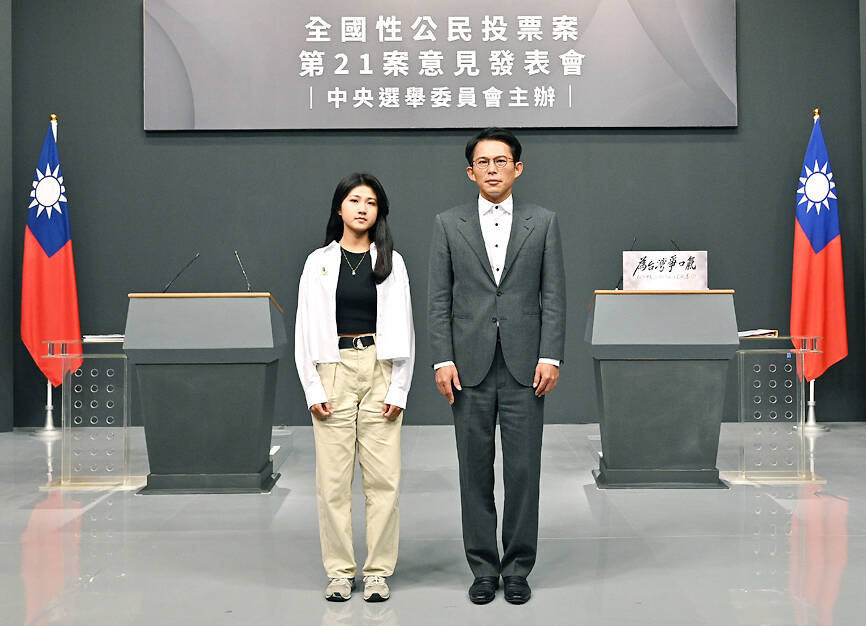A fourth televised public debate about restarting the recently decommissioned Ma-anshan Nuclear Power Plant next to Ma-anshan (馬鞍山) in Pingtung County was held yesterday, ahead of a national referendum on the controversial issue in less than two weeks.
A referendum on Saturday next week is to ask voters if they agree that “the Ma-anshan Nuclear Power Plant should continue operations upon approval by the competent authority and confirmation that there are no safety concerns.”
Taiwanese who are 18 years old or older can vote in the referendum.

Photo courtesy of the Central Election Commission
The vote comes just three months after the power plant’s final reactor shut down on May 17, officially making Taiwan nuclear-free.
Taiwan People’s Party Chairman Huang Kuo-chang (黃國昌) represented the side in favor, while 20-year-old university student Wu Ya-hsin (吳亞昕) represented the opposition.
Addressing concerns about whether nuclear power plants represent a national security vulnerability, Huang cited a report from the Center for Strategic and International Studies, a US think tank, that said Taiwan’s energy grid lacks resilience and needs nuclear power.
The report, a war game simulation of a Chinese blockade, said that the government’s decision to shut down the reactor for environmental reasons “greatly increased Taiwan’s energy vulnerability.”
The Democratic Progressive Party knows it should not abandon nuclear energy, as President William Lai (賴清德) last year confirmed that the government has contingency plans to maintain nuclear power capabilities, Huang said.
Huang downplayed concerns about the disposal of nuclear waste, saying that the Ministry of Economic Affairs has already engaged with nuclear disposal facilities in Europe for assistance.
A new technology, deep borehole disposal (DBD), is safe and feasible, and well suited for Taiwan’s small land area, dense population and plate tectonics, he said.
DBD is not a theoretical breakthrough — it is a turning point for nuclear policy, he added.
The Ma-anshan Nuclear Power Plant can still hold 562 bundles of nuclear rods, enough to power the plant for three cycles of 18 months each, or about five years in total, he said.
The plant is also finalizing plans to construct a new storage facility that would allow it to continue operating without concerns, he said, adding that the claim that its service life can only be extended by four to five years is “completely false.”
Wu brought up the example of Japan’s Fukushima Dai-ichi nuclear power plant disaster.
Fourteen years later, 24,000 residents still cannot return home due to concerns about radiation, and at least 300 young people have developed thyroid cancer, she said.
She read out loud a letter from a resident of Fukushima, which mentioned the numbers and stated that a nuclear accident can have consequences for up to a century.
Many people claim nuclear power is inexpensive and clean, but the Fukushima experience shows that costs and recovery time in the aftermath of an accident are enormous, she added.
She cited the latest report by Taiwan Power Co saying that the Ma-anshan reactors lie only 900m from a fault, adding that when the plant was first built, geological knowledge lagged far behind what it is today.

SHIPS, TRAINS AND AUTOMOBILES: The ministry has announced changes to varied transportation industries taking effect soon, with a number of effects for passengers Beginning next month, the post office is canceling signature upon delivery and written inquiry services for international registered small packets in accordance with the new policy of the Universal Postal Union, the Ministry of Transportation and Communications said yesterday. The new policy does not apply to packets that are to be delivered to China, the ministry said. Senders of international registered small packets would receive a NT$10 rebate on postage if the packets are sent from Jan. 1 to March 31, it added. The ministry said that three other policies are also scheduled to take effect next month. International cruise ship operators

NUMBERS IMBALANCE: More than 4 million Taiwanese have visited China this year, while only about half a million Chinese have visited here Beijing has yet to respond to Taiwan’s requests for negotiation over matters related to the recovery of cross-strait tourism, the Tourism Administration said yesterday. Taiwan’s tourism authority issued the statement after Chinese-language daily the China Times reported yesterday that the government’s policy of banning group tours to China does not stop Taiwanese from visiting the country. As of October, more than 4.2 million had traveled to China this year, exceeding last year. Beijing estimated the number of Taiwanese tourists in China could reach 4.5 million this year. By contrast, only 500,000 Chinese tourists are expected in Taiwan, the report said. The report

HORROR STORIES: One victim recounted not realizing they had been stabbed and seeing people bleeding, while another recalled breaking down in tears after fleeing A man on Friday died after he tried to fight the knife-wielding suspect who went on a stabbing spree near two of Taipei’s busiest metro stations, Taipei Mayor Chiang Wan-an (蔣萬安) said. The 57-year-old man, identified by his family name, Yu (余), encountered the suspect at Exit M7 of Taipei Main Station and immediately tried to stop him, but was fatally wounded and later died, Chiang said, calling the incident “heartbreaking.” Yu’s family would receive at least NT$5 million (US$158,584) in compensation through the Taipei Rapid Transit Corp’s (TRTC) insurance coverage, he said after convening an emergency security response meeting yesterday morning. National

The Forestry and Nature Conservation Agency yesterday launched a gift box to market honey “certified by a Formosan black bear” in appreciation of a beekeeper’s amicable interaction with a honey-thieving bear. Beekeeper Chih Ming-chen (池明鎮) in January inspected his bee farm in Hualien County’s Jhuosi Township (卓溪) and found that more than 20 beehives had been destroyed and many hives were eaten, with bear droppings and paw prints near the destroyed hives, the agency said. Chih returned to the farm to move the remaining beehives away that evening when he encountered a Formosan black bear only 20m away, the agency said. The bear